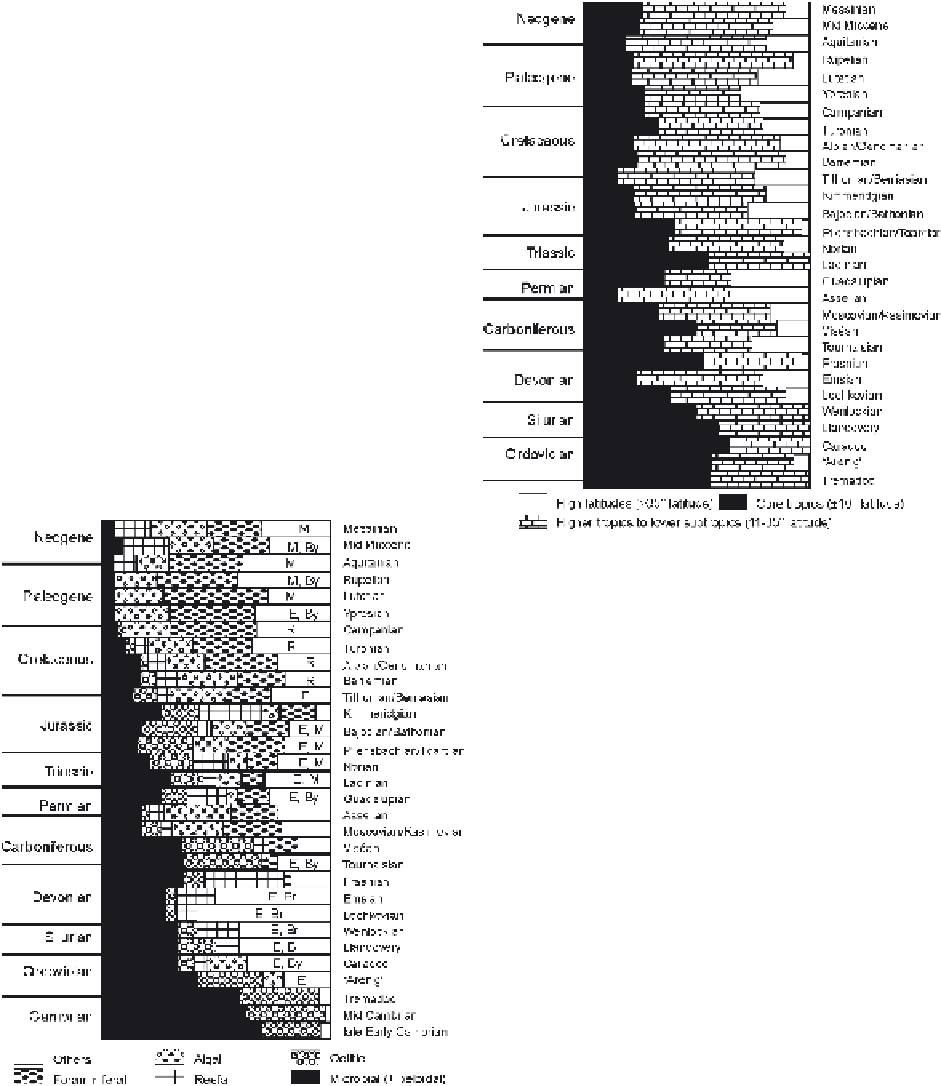Geology Reference
In-Depth Information
acterized by spectacular crystal fans of former arago-
nite. The crystal stromatolites form extensive bioherms
and biostromes, with stacked reefs at the paleoshelf
edge.
The following discussion is limited to trends in the
development of Phanerozoic carbonate sediments.
16.7.1.1 Phanerozoic Carbonate Platforms
Carbonate platforms changed substantially in spatial
extent, geometry, composition and paleogeographical
distribution throughout the Phanerozoic (Kiessling et
al. 2003). Trends in paleogeographical distribution and
spatial extent are related to continental drift, evolution-
ary patterns of carbonate platform biotas, climatic
change, and possibly, variations in ocean chemistry. A
critical analysis of Phanerozoic platforms exhibits the
following trends:
Fig. 16.21.
Latitudinal distribution of relative carbonate plat-
form area.
The Cambrian is not shown because of problem-
atic plate reconstructions. The latitudinal range of platform
deposits varied markedly. Note the decline in carbonate pro-
duction in the core tropics and the increase in the proportion
of carbonate production in the higher tropics and lower sub-
tropics in post-Paleozoic times. For the Carboniferous, Per-
mian and Neogene, high latitude carbonate platform posi-
tions coincide with global cooling. These platforms exhibit
profound qualitative differences in grain associations by com-
parison to tropical platforms (see Sect. 12.2). After Kiessling
et al. (2003).
•
Carbonate platform composition
shifted from a mi-
crobial-oolitic dominance in the Cambrian and Early
Ordovician to an echinoderm-bryozoan-brachiopod
dominated composition in the later Early Paleozoic
(Fig. 16.20). Late Paleozoic and younger platforms are
usually strongly influenced by algal and benthic fora-
miniferal production. Echinoderms retained their rock-
building potential until the Jurassic. Rudist bivalves
contributed significantly to Late Cretaceous platforms,
whereas other mollusks, with a few exceptions in the
Late Paleozoic and Early Mesozoic, achieved a rock-
building potential only in the Cenozoic.
• The
paleogeographical distribution
of carbonate
platforms shows two significant trends: The latitudi-
nal range of platform sedimentation widened and the
relative coverage of equatorial shelves by carbonate
platform sedimentation declined through the Phanero-
zoic (Fig. 16.21).
•
Paleozoic carbonate platforms
were much larger and
less scattered on average than Mesozoic and Cenozoic
Fig. 16.20.
Composition of Phanerozoic carbonate platforms
in 32 supersequences. The names used for supersequences
(right) correspond to the time of maximum transgression
within the supersequence that has a wider range (e.g. the des-
ignation Tremadoc comprises Latest Cambrian to earliest Or-
dovician; see Golonka and Kiessling 2002). The plot refers
to tropical and subtropical platforms. The most prominent
groups in the 'Others' category are indicated by Br - brachio-
pods, By - bryozoans, E - echinoderms, M - mollusks, and R
- rudist bivalves. Note the difference in the composition of
Paleozoic and Mesozoic to Cenozoic platform carbonates.
After Kiessling et al. (2003).

